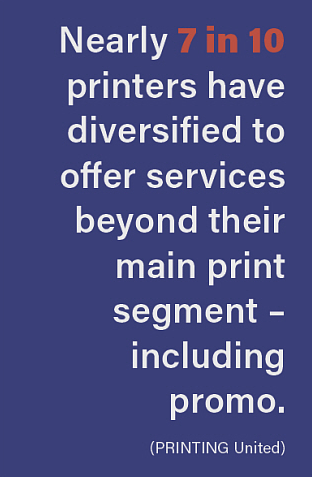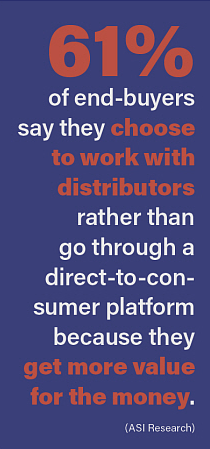Randy Eubanks, now an account executive at the Florida division of distributor Smart Source (asi/328914), sold his first promotional product when one of his print clients – a jet engine manufacturer – asked him for what essentially was an enormous bright yellow shower cap imprinted with the company logo to stretch over a piece of their jet engines.
After more than a little confusion about where one would find such a product – and significant trial and error about decoration – Eubanks was successful. He was also now in the promo products business.
As the anecdote indicates, the same people that buy print solutions likely have promo in their marketing budgets, and the same people that purchase promotional products often buy print. The advantage in becoming a one-stop shop for clients and offering both? It can make you an indispensable resource. “If they’re buying five print products and 10 promo products, there’s a low chance of them finding somebody else that can match all the things you’re doing for them,” says Paul Keely, owner of Newark, DE-based distributor King Print & Promo. “That makes you ridiculously valuable and pretty much irreplaceable.”
Despite the similarities between the print and promo markets, distributors transitioning from one medium to the other can face unique challenges because of the distinctions between the two. Here are the essentials you need to know about both.
What the Print Industry Needs To Know About Selling Promo
1. You already have the basic art and color knowledge to be successful.
If someone is coming from a print background, they likely already understand how vector art, colors and ink work, says Eubanks.
And if you aren’t decorating in-house, Keely says, there isn’t a lot of risk with getting started in promo because you don’t have to spend thousands of dollars on inventory or equipment; it’s possible to enter the promo business without significant investment.
Of course, you have to learn a new product catalog and develop an understanding of the promo market, Eubanks notes, but once you cultivate relationships with promo suppliers, they’ll help you through many of the learning curves.
One of the biggest potential gaps moving from print to promo is decoration techniques – knowing the difference between embroidery and silk screen, for example, or being able to articulate the costs that go into imprinting. “Knowledge is powerful in this business,” says Eubanks.
2. The vendor and product options are vast.
Another learning curve? Where your products come from.
There are thousands of promo suppliers in the U.S. offering a wide range of items, from classic pens and water bottles to customized camera detectors and pickleball kits. Promo’s product selection can feel exceedingly vast for someone just entering the space – especially before connecting with suppliers by joining a membership organization like ASI or attending industry trade shows. Even after you find the right product for a client, other decisions need to be made about elements like colors and exact logo placement.
As in print, it’s important to narrow down the possibilities as much as possible based on what a customer needs, and then present those select picks. “I try not to overwhelm my clients with options,” says Connie Root, promotional sales consultant for Oklahoma-based distributor Walker Companies (asi/354535). “We’ve talked about what they’re looking for, so I try to give them a ‘good, better, best’ selection, and then we go from there.”
3. Build in more time than you think you need for samples and shipping.
Unless it’s for something specialized, printers don’t produce a lot of physical samples, says Jay Sedgwick, a senior account executive at distributor npn360 (asi/285252), headquartered in Illinois.
However, it’s often the opposite for promo, he added. Samples are an important part of the process, especially when a client is trying to decide whether or not to invest in a more expensive option. “I always make sure a client will have an opportunity to try on a shirt or write with a pen or play with a backpack,” Sedgwick says. “We don’t necessarily do that in printing.”
While direct-to-film technology – a promo decoration technique on the rise – has made print-on-demand orders easier and quicker than ever, it still takes time to get through the ordering process, especially when shipping is factored in.
Consider: Because you’re relying on an external supplier for your materials and decorating, it’s critical to budget more shipping time than you think you need.

4. Sell promo as a solution, not just ‘more stuff.’
The promo industry has experienced some anti-swag sentiment in recent years, stemming from concerns over sustainability.
It can be tempting, distributors say, to just go for the cheapest product option to give your client the lowest price. But it’s more important, says Sedgwick, to focus on promo items you can vouch for as a salesperson. People are much more likely to hang onto quality products long-term, which both ups the sustainability factor and ensures your brand gets more impressions per product.

It makes good business sense to do so: ASI Research has found that 80% of end-buyers consider durability when buying promotional products from distributors – the highest variable over even price or function.
Ensuring high quality can come by getting samples from suppliers to test out yourself. It also might mean sourcing premium retail brands through promo suppliers that carry them. Such name recognition tends to increase perceived value. And, of course, promo has made huge strides in bringing to market products made with eco-friendly materials in a manner that has less impact on the planet than in the past. “Those end-customers really do want something that they’re going to use, that they see as a value-add, versus another cheap tchotchke item that is going to end up in the trash,” says Colin Wheatly, sales operations manager at California-based supplier Ember Technologies (asi/52191).
What the Promo Industry Needs To Know About Selling Print
1. You need to gain technical knowledge to be successful.
Distributors who provide both print and promo services are generally in agreement – learning print is tougher than learning promo. “Promo is pretty structured,” Keely says. “Print is the wild, wild West.”
He describes it that way because there’s a large number of options within an individual order. When you consider color, texture, weight, size and grade, there are seemingly endless sheets of paper out there, says Sedgwick.

Technical knowledge of those paper types – as well as other attributes like typesetting, design and ink – is critical for ensuring print projects come out correctly.
As just one small example of the knowledge needed, annual report covers almost always have a varnish that adds shine and prevents scratches. There’s also the question of if customers want the covers to be the thickness of an index card or bulkier, like a business card. Or, if they want their event fliers printed on basic uncoated copier paper, how long are the fliers expected to last? They might need a heftier paper to stand up to the elements for a week or more.
“Most promotional products people, when they look at a piece of paper, it’s a piece of paper,” Eubanks says. “But there are so many variances, and if you get it wrong, the customer wants it reprinted. The old saying is, once it’s printed, ‘If they don’t want it, it’s wallpaper.’”
2. Artwork and graphic design present a challenge.
Because there’s typically a larger surface area to cover than your standard promotional product, artwork and graphic design on print projects can prove to be complex.
Artwork that’s blurry or the wrong size can take a lot more back-and-forth with the client to resolve if it’s more complicated than a logo and a few words, according to industry pros. When working on a brochure with thousands of words of text, there’s proofreading involved in addition to the visuals. And sometimes the client provides no art at all, since printers are often heavily involved with the design process.
If you don’t have someone to properly typeset a project to get it ready to print – a more complex process than sending off artwork for promo – that presents a barrier for many promotional products distributors, says Darrell McChesney of distributor Team Iowa (asi/342486).
Having a graphic designer on staff who can both aid with imperfect artwork and help clients design effective print products is a massive asset in the print world. Or, consider developing relationships with trade printers. This segment of the industry serves as a “print supplier” of sorts for those who don’t print in-house. They can handle certain of the more taxing technical bits and fulfill end-client orders for you.
3. Print faces certain key competitive challenges.
Much like the anti-swag sentiment some promo distributors face, there are clients who argue “print is dead,” Keely says. That’s due to sustainability concerns as businesses move some items, like forms, to digital formats.
Still, so many tangible things must be printed for use in the physical word. And, print is getting greener. Various print mediums are moving to more environmentally friendly practices, production and materials. Seek those out and tell their story to clients.
Meanwhile, another endemic challenge in the print market is competition from big box or online printers like Staples, VistaPrint or even graphic design tool Canva, where customers can quickly order business cards or other products at low costs. “Pricing is a challenge on the print side,” McChesney says, because “people can go online and find things for considerably less.”
That user ease only extends so far, though. If there are order challenges or a last-minute error, says Sedgwick, it’s probably a salesperson at a print distributor that’s going to be able to take care of an emergency. And that’s where being well-versed in the industry and technical specs can set you apart.

4. It’s important to be strategic about your print product offerings.
Stiff competition online is why new printers have to be strategic about what print products they spend their time learning about, and what they end up offering, says Sedgwick.
Business cards, for example, can be a loss leader in print, if that’s all you’re doing. McChesney says the effort it takes to set up and fulfill the occasional business card order doesn’t usually match up with ultimate profits.
That said, a category like direct mail has more opportunities for large-scale orders, Sedgwick notes. Also, getting involved with packaging and kitting can provide seamless integration with promo campaigns. Distributors can provide custom print packaging for an influencer merch campaign, for example, or add a printed thank-you card to an employee appreciation gift, thereby merging traditional print solutions with promo products.
“If they’re just wanting to do a business card every six months to a year, that’s not really going to put that much on your bottom line,” Root said. “But if they’re a customer that does a lot of fliers and brochures and detailed print work, that’s going to be worth your time.”



